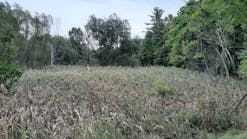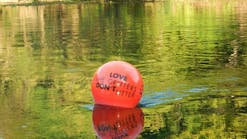Throughout my childhood in the Pacific Northwest, a common family activity was to walk on the beach. For us kids, there were rocks to throw, shells to inspect, and crabs to catch. For my mom, there was trash to collect. Although she wasn’t actively looking for it, she would wander up or down the beach several yards if she spotted anything, and by the end of our walk, she’d usually have a small handful for the garbage can. It’s a habit she continues to this day and one she’s passed on to me.
The trash my mom and I are accustomed to finding is the usual beach detritus—water bottles, food wrappers, bits of mystery plastic—and rarely very much. Most of the trash was clearly either left behind by beachgoers or washed up with the tide. But I recently read about a beach not far from where I grew up where the trash is coming out of the ground.
You wouldn’t know it if you visited, but Blaine Marine Park in Blaine, WA, is built on top of an old landfill. There’s a walking path along a rocky shoreline that’s spotted with seabirds, and across the water are the evergreen-covered hills typical of coastlines in British Columbia and Washington. Last week, though, I came across an article in a local newspaper, The Northern Light, about an increase in trash appearing on the shore recently. Laura Friend is a volunteer with a local group, the Coastal Observation and Seabird Survey Team (COASST) and is tasked with tracking large pieces of debris on the beach. She’s noticed an increase in trash lately and told the newspaper she believes that recent wind and high tides are eroding the beach and exposing the former landfill.
The waste in a landfill is certainly different from the kind of trash my mom and I found on our beach walks, and more dangerous both to humans and the wider environment. Take batteries for example; they contain chemicals including lithium, lead, mercury, potassium, and cadmium, which is why they need to be disposed of specially. However, many end up in the landfill, and if the landfill erodes into the ocean, hazardous materials like those in batteries can end up on beaches or in the water, endangering humans and marine life.
According to the article, the city of Blaine is aware of the problem, and references the “Marine Park Shoreline Reconstruction & Naturalization Pilot Project.” The project’s page on the city website outlines the plan to deal with the exposed historic landfill and mitigate erosion more generally. “We were able to clean that garbage debris, remove it from the shoreline, cap it and bring in native materials such as rocks, boulders, and logs to rebuild that headland,” Blaine City Planner Alex Wenger told The Northern Light.
The current shoreline was created using chunks of concrete curbing and quarried rock in the 1960s, and the project’s website points out that “the jumble of broken debris is an ineffective stabilization measure.” By creating a shoreline with low slope angles and high porosity, the aim is to reduce and dissipate the force of the tides. Finally, native plants will be used to create habitat for birds and marine life.
Working to prevent the erosion of a historic landfill onto a public beach certainly has some unique challenges. If you have experience working on sediment and erosion control related landfills, historic or current, send your comments to [email protected].
Rachel Sim | Editor
As the editor of Stormwater magazine from June 2019 to December 2020, Rachel Sim created and curated quality content addressing the challenges faced by surface water and erosion control professionals, focusing on cutting-edge technology and the latest environmental research.






